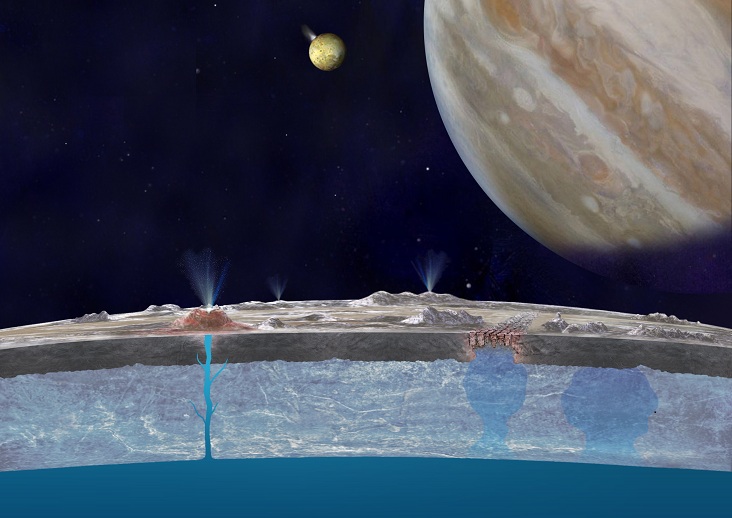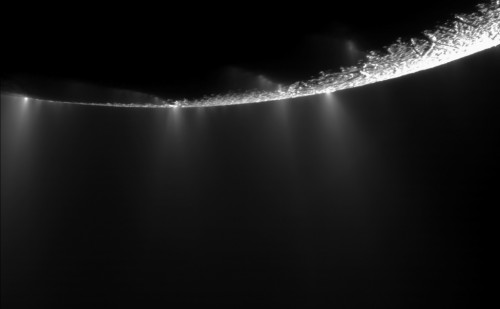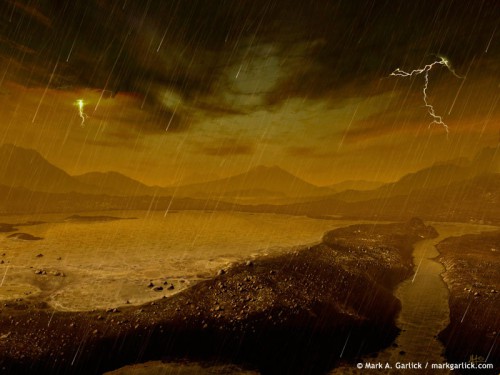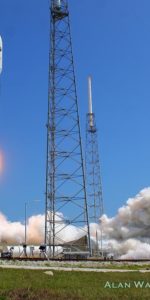
The exploration of the outer Solar System has revealed a plethora of amazing worlds, the likes of which were little known or even unheard of just a decade ago. Among the most remarkable and tantalizing discoveries are the “ocean moons” such as Europa and Enceladus, which have oceans or seas of liquid water beneath their icy surfaces. Other moons like Titan, Ganymede, and Callisto may also have them, and even some asteroids. Titan also has seas and lakes of liquid methane/ethane on its surface. With all that water, these small worlds have become a primary focus in the search for possible life elsewhere in the Solar System. Now, a new NASA budget proposal wants to take that a step further and fund new missions to these watery moons.
The 2016 budget proposal from the U.S. House Appropriations Committee calls for the creation of an “Ocean Worlds Exploration Program” which would fund new missions to Europa, Enceladus, and Titan. From the proposal:

“Many of NASA’s most exciting discoveries in recent years have been made during the robotic exploration of the outer planets. The Cassini mission has discovered vast oceans of liquid hydrocarbons on Saturn’s moon Titan and a submerged salt water sea on Saturn’s moon Enceladus. The Committee directs NASA to create an Ocean World Exploration Program whose primary goal is to discover extant life on another world using a mix of Discovery, New Frontiers and flagship class missions consistent with the recommendations of current and future Planetary Decadal surveys.”
This is exciting news for those who have been advocating such missions. The bill provides $140 million to continue development of a new Europa mission, including a lander—$110 million more than requested. An additional $86 million goes toward developing new missions to Enceladus and Titan.
As Kevin Hand, a senior scientist at NASA’s Jet Propulsion Laboratory, noted: “The next few decades, if our exploration proceeds in a visionary manner, there are three key missions from the standpoint of searching for extant life. We should go to Europa and explore its subsurface ocean. We should land in the methane, and ethane lakes of Titan. And We should fly through and dive into the plumes of Enceladus.”
The bill also calls on NASA to launch the Europa mission by 2022; previously, NASA had only committed to a vague “mid-late 2020s.” The mission would utilize the Space Launch System (SLS) and may be a version of the previously proposed Europa Clipper, which would make repeated flybys of the moon. A lander, of course, would be a fantastic addition.
NASA’s Planetary Science Division receives $1.557 billion in funding overall, a very welcome announcement.

Jupiter’s moon Europa has long been of astrobiological interest to planetary scientists; a global water ocean lies beneath the outer icy crust, which is now thought to be quite similar to Earth’s oceans or soda lakes in salinity. New evidence suggests there is even sea salt on Europa’s surface. The rocky ocean floor could also provide nutrients and minerals for any putative life forms. With water, heat, and nutrients available, the Europan ocean is now considered to be one of the best places in the Solar System to search for life, even if only microbes. Even the darkest, deepest oceans on Earth are teeming with life.
More recently, Saturn’s moon Enceladus has been added to the water worlds list. The Cassini spacecraft found geysers of water vapor/ice crystals erupting from deep fissures in the moon’s icy surface at the south pole. They are now thought to originate from a subsurface ocean or sea of water, much like on Europa. There is also now evidence for hydrothermal activity on the ocean floor, much like on Earth. Cassini has already flown through and sampled the plumes directly, finding water vapor, ice crystals, salts, and organics. Cassini can’t identify living microbes in the plumes, but the data it has returned now makes Enceladus another place that scientists are keen to explore further.
Titan, Saturn’s largest moon, is very unique, with seas, lakes, rivers, and rain of liquid methane/ethane. It is much too cold for liquid water on the surface, but Cassini has also provided evidence for a subsurface ocean on this moon as well, although little else is known about it at this point. According to some scientists, it is also conceivable that some kind of primitive life could exist in the hydrocarbon seas and lakes, although it would be quite different than anything on Earth. Titan’s surface and atmosphere are both rich in organic material; even if there is no life, Titan is still considered to be a deep-freeze version of early Earth, with possible pre-biotic chemistry occurring which could provide clues to how life started on Earth.
All three of these moons provide a unique opportunity for exploration in the outer Solar System and could help to answer the question of how life arose on Earth and whether it exists anywhere else in the Solar System.
Another positive note is that the bill provides funding for both the Opportunity rover on Mars and the Lunar Reconnaissance Orbiter to continue after being faced with possible cancellation. As noted by Eric Berger, “This is a marvelous day for planetary science and the search for life.”
More information regarding the budget for planetary exploration overall is available here, and the budget in its entirety is here.
Want to keep up-to-date with all things space? Be sure to “Like” AmericaSpace on Facebook and follow us on Twitter: @AmericaSpace






Awesome Paul.
After the Moon, we must bypass tainted Mars and go straight to Ceres, Titan and the subsurface ocean paradises of the outer planet ice moons.
With SLS wet workshops and robot landers to shuttle ice products up from deposits at the lunar poles; Semi-expendable robots can land on these deposits, take on a load of water- and the volatiles trapped in the ice- convert some of it into propellent and then return to the empty upper stages in lunar polar “frozen” orbit and transfer the water. And then repeat. The workshops will eventually have massive radiation shields and be waiting for astronauts to come and start the real work. One of the first projects being to attach a thousand foot plus tether system to a pair of these workshops to provide artificial Earth gravity. This could theoretically be accomplished with just three SLS launches; the two workshops with their landers and a third later bringing the astronauts and tether system.
The result would be a one gravity fully shielded true space station in lunar orbit with near sea level radiation and proof against the worst possible solar event.
Add a nuclear propulsion system and send astronauts to those moons. We could do it in 10 years just like Apollo if we shoveled 4.4 percent of the budget into it. Not much chance of that happening unless there is a monolith out there though.
But it does make sense to build space stations using the Moon and transiting them back into GEO to capture the over 100 billion dollars of the telecom industry. Unfortunately that would require a state-run public works Apollo type program and that is anathema to the administration determining space policy at the present moment.
Interestingly, about a trillion dollars is slated to go into replacing our aging strategic nuclear deterrent over the next ten years or so. Put those bombs on spaceships and send them into deep space and those military people might as well do some exploring and even take a few scientists with them. Maybe a couple mini-subs also.
http://www.nasa.gov/pdf/55583main_vision_space_exploration2.pdf
On page 22 you will find a depiction of a base on Callisto.
Europa and Ganymede are unfortunately a challenge for human explorers because of the lethal surface radiation. A shielded spaceship could still land and melt a submarine shaft through the ice into a subsurface ocean and not expose humans to radiation- but surface exploration even for a short walk not possible.
Callisto is outside Jupiter’s deadly radiation belts so limited surface exploration is no problem. It is much larger and than our Moon though because it is icy and has less mass it has less gravity at .126G compared to a lunar .165G. Though a living ocean on Callisto is less probable due to a lack of tidal heating it is still possible. The same holds true for Ceres by the way. One space journalist who will not be named embarrassed himself by inquiring about Ceres tidal heating during one of the first press conferences.
So setting up a base on Callisto would be easier than on Europa or Ganymede and might be a possibility.
This is a FANTASTIC “dream-come-true” proposal!! For once, Congress has the opportunity to do something for US, the large number of individuals who have raged in frustration for years over the apathy and antipathy of the general public, Congress, and various Presidents. Before I muster the hope and energy to pull myself up one last time from the dust of crushed human space flight/planetary exploration dreams, could you please tell me Paul if you have had the opportunity to discuss this proposal with Jim Hillhouse? Jim is “THE” source for what is really happening on Capitol Hill. A very astute, intelligent, logical individual, Jim will tell the whole truth as it is without Newspace cheer-leading, wishful thinking, and zealous worship of “The Musksiaah”. If Jim says that this proposal has a good chance of passing, yours truly is off to buy a top-shelf bottle of scotch! 😀
Glad to see that efforts to study new missions to interesting destinations like Europa, Enceladus, Titan and other outer solar system destinations are getting badly needed seed money to do required development work. But having been an observer of planetary missions for four decades, I know the real test will come when the hundreds of millions of dollars required to build, launch and fly these missions are needed. We’ll see what Congress does then.
On a side note, I’m glad to see that there is funding for continuing the Opportunity Mars rover mission and LRO. It would be a real waste to shut down these missions that are still producing so much excellent science.
“On a side note, I’m glad to see that there is funding for continuing the Opportunity Mars rover mission and LRO.”
Agreed, especially on the LRO.
Agreed. If Opportunity got the axe, as it were, it would be disappointing but it has been running for over a decade and is well past it prime (with stiff arm joints, memory issues, etc.). LRO is still very much in its prime and has much good science to contribute.
“They even “zeroed out” funding for the long lived Opportunity rover.”
Did I not understand that Opportunity Rover is being shut down?
In the second to last sentence of this article it states “Another positive note is that the bill provides funding for both the Opportunity rover on Mars and the Lunar Reconnaissance Orbiter to continue after being faced with possible cancellation. As noted by Eric Berger, “This is a marvelous day for planetary science and the search for life.””
Of course, this is referring to the House version of the 2016 budget which differs from the Administration’s original budget proposal (which proposed cutting Opportunity and LRO)… and who knows what the Senate version will look like.